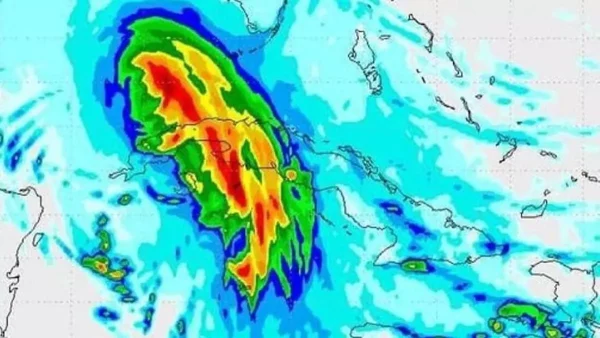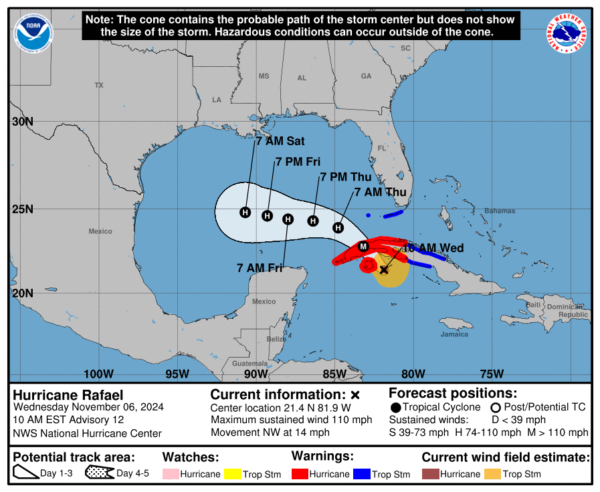Hurricane Rafael Prepares to Enter Western Cuba

Cubans lament that the lack of electricity and water has hindered their preparations for the hurricane.
HAVANA TIMES – Having reached Category 2 at 7:00 am this Wednesday, Hurricane Rafael is moving northwest at a speed of 22 km/h (14 mph). According to the National Institute of Meteorology (Insmet), the cyclone “will continue on a similar course and speed” through the seas surrounding western Cuba before entering the island from the south, between Artemisa and Pinar del Rio.
The center of the storm, advancing with maximum sustained winds of 175 kilometers per hour (110 mph), was located at 10:00 a.m., 95 kilometers (60 miles) east-southeast of Isle of Youth and 205 kms. (130 miles) south-southeast of Havana, reports the National Hurricane Center in Miami.
“Numerous rains, showers, and thunderstorms have been reported in eastern and central regions overnight, which will increase today in western Cuba. These precipitations will persist over the next 24 hours, and will be strong and intense, with accumulations between 100 and 200 millimeters (2.5 to 5 inches), possibly higher in some areas,” adds Insmet.
There will be “strong swells” along the southern coast, with expected moderate to severe flooding in Sancti Spíritus, Cienfuegos, Matanzas, Mayabeque, Artemisa, and Pinar del Río, as well as Isle of Youth and the Canarreos archipelago.
These provinces, along with Villa Clara and Havana – without southern coasts – were placed under “cyclonic alarm” by the Civil Defense State Major on Tuesday. Guantanamo, Santiago de Cuba, Holguin, Granma, Las Tunas, Camagüey, and Ciego de Ávila remain in a watch phase.
Granma daily warned Cubans that “a Category 2 hurricane can cause severe damage to the roofs of well-structured homes, topple or uproot shallow-rooted trees, blocking numerous streets, and leave some areas without electricity.”

The situation many people are facing
“We were told to evacuate on our own, but we hardly have any family left here in Havana; those who haven’t left have passed away,” said Lourdes, 64, who lives near Havana’s Central Park. Her third-floor apartment in an early 20th-century building that has suffered several partial collapses.
A mother of two and grandmother of three, Lourdes tried to reach out to a cousin in Miami to use her apartment in Cerro, but it was unsuccessful. “She doesn’t want to let anyone in because she says if our place collapses, we’d end up staying there, so we’re making arrangements with neighbors to stay with them tonight.”
Near Lourdes’ house are numerous homes left vacant due to their owners emigrating. Some used to be prosperous tourist rentals, but now only caretakers, paid from abroad, occasionally visit to ensure no one intrudes or steals valuables.
In the municipality of Plaza de la Revolucion, one of Havana’s most central areas, some neighborhoods have been without water since last week. El Vedado, home to various ministries, has been hit hardest by hydraulic deterioration. In its lower areas, where coastal flooding from Rafael is expected, residents have been without water for over 72 hours.
“It’s hard to understand that, when we’re likely to be without electricity for several days once the hurricane arrives, they didn’t pump water to this part of the city over the weekend or on Monday. We couldn’t store anything,” laments Gladys, a resident near Havana’s Malecon seawall.
In Santo Suarez, La Lisa, Marianao, and parts of Diez de Octubre, the situation is the same. “We have small children, empty tanks on the rooftops. When does disrespect end? It’s inhumane what they’re doing; we have to live in constant stress,” one internet user bitterly complained on the Facebook page of state-run Aguas de La Habana, a company that, along with the Electric Union company, has become a target of public discontent.
Most food delivery sites for the island have closed since Tuesday. Ricardo, 79, was among the last to receive a food delivery ordered by his daughter from Madrid, just before they stopped taking orders.
Crackers, instant soups, powdered milk, and bread were among the products that reached Ricardo during a day of urgency. Such items were in high demand at local private stores throughout the day, as confirmed by an employee at a store near Centro Habana’s Infanta and San Lazaro streets.
“We sold a lot, especially non-refrigerated foods because people are afraid of prolonged blackouts, like last month when refrigerated food spoiled,” she explains. Prices were shocking: 400 pesos for a can of condensed milk, 750 for a liter of oil, and 450 per kilogram of flour. Sugar, if found, goes for over 550 pesos. [This in a country with an average monthly wage around 4,000 pesos ($12 USD) and many pensions of under $5 USD.]
At 4:00 am on Wednesday, the official press summarized a meeting of the Communist Party in Pinar del Rio, where the biggest impact is expected, announcing that municipalities like La Palma and Bahía Honda are likely to face the hurricane’s exit from Cuba.
Entire communities were evacuated in the province, like Sanguily, while others were warned of their high risk, especially Los Palacios, which “tend to become isolated” during disasters. “There are 68 centers for population evacuation. About 5,928 people are staying in the homes of family and friends. Of these, 55 are in evacuation centers in Los Palacios and 12 in Mantua,” they added.
There are 18 tourists in the province who “should leave this Wednesday” if the cyclone allows, and those in the Maria La Gorda hotel have been moved to the Vueltabajo hotel. Additionally, 43 foreign students were relocated to a Medical University evacuation center.
The province’s reservoirs are at 94% capacity due to the rains, but limited water supply remains a concern as Rafael approaches. Authorities distributed 200 tons of rice and some additional basic products in all municipalities, according to Granma. However, “it was decided not to move the cooking oil” in case the rains complicate its transport.
Rafael is the second major weather event to hit Cuba in recent weeks. On October 21, Category 1 Hurricane Oscar entered Guantánamo province, later weakening to a tropical storm before leaving the island via Holguín province. The recovery effort in the effected municipalities is only in the initial stages.
Meteorologists had forecast a highly active hurricane season from June 1 to November 30, and recent events have proven them right. Rafael approaches the island amidst severe energy shortages. On Monday, several Cuban regions went up to 20 hours without electricity, complicating food preservation and battery charging in preparation for the hurricane’s arrival. In Havana, water supply issues have worsened in recent days.
First published in Spanish by 14ymedio and translated and posted in English by Havana Times.
Read more from Cuba here on Havana Times.






Relatively speaking, Cuba normally does a very good job preparing for hurricanes. The lack of electricity before the hurricane obviously complicates preparations. However it is standard practice in Cuba, as it is in many places, to cut power just as a hurricane makes landfall. Post hurricane, recovery and clean-up will likely take longer. Worse yet, there appears to be the possibility of another major storm hitting the island. Pobrecito Cuba.